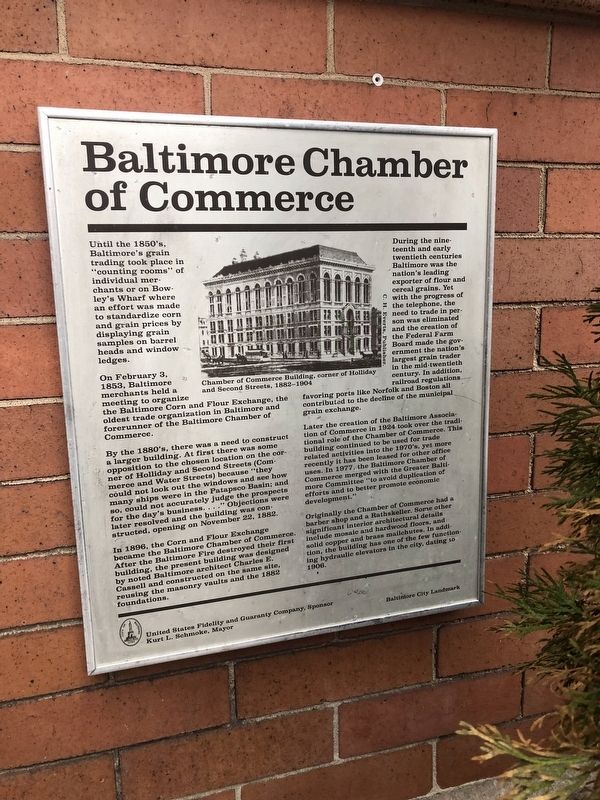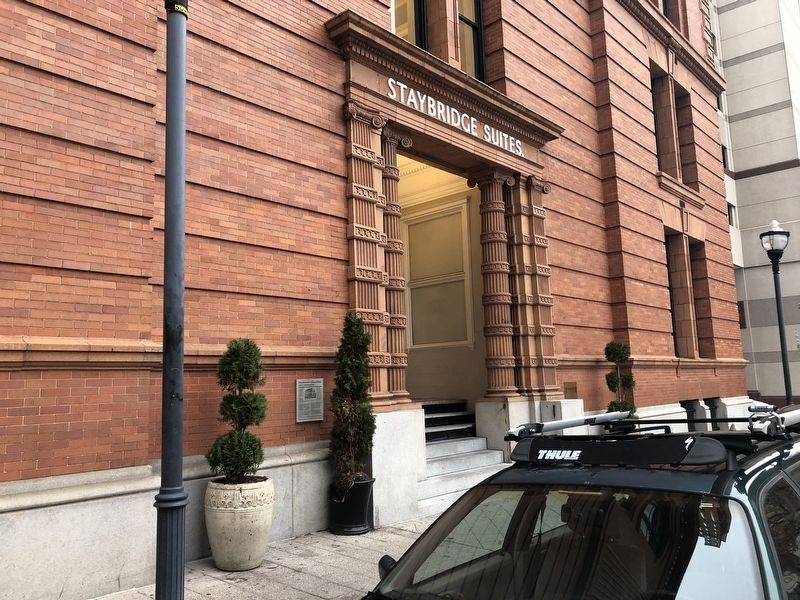Downtown in Baltimore, Maryland — The American Northeast (Mid-Atlantic)
Baltimore Chamber of Commerce
Baltimore City Landmark
Until the 1850's, Baltimore's grain trading took place in "counting rooms" of individual merchants or on Bowley's Wharf where an effort was made to standardize corn and grain prices by displaying grain samples on barrel heads and window ledges.
On February 3, 1853, Baltimore merchants held a meeting to organized the Baltimore Corn and Flour Exchange, the oldest trade organization in Baltimore and forerunner to the Baltimore Chamber of Commerce.
By the 1880's, there was a need to construct a larger building. At first there was some opposition to the chosen location on the corner of Holliday and Second Streets (Commerce and Water Streets) because "they could not look out the windows and see how many ships were in the Patapsco Basin; and so, could not accurately judge the prospects for the day's business...." Objections were later resolved and the building was constructed, opening on November 22, 1882.
In 1896, the Corn and Flour Exchange became the Baltimore Chamber of Commerce. After the Baltimore Fire destroyed their first building, the present building was designed by noted Baltimore architect Charles E. Cassell and consructed on the same site, reusing the masonry vaults and the 1882 foundations.
During the nineteenth and twentieth centuries Baltimore was the nation's leading exporter of flour and cereal grains. Yet with the progress of the telephone, the need to trade in person was eliminated and the creation of the Federal Farm Board made the government the nation's largest grain trader in the mid-twentieth century. In addition, railroad regulations favoring ports like Norfolk and Boston all contributed to the decline of the municipal grain exchange.
Later the creation of the Baltimore Association of Commerce in 1924 took over the traditional role of the Chamber of Commerce. This building continued to be used for trade related activities into the 1970's, yet more recently it has been leased for other office uses. In 1977, the Baltimore Chamber of Commerce merged with the Greater Baltimore Committee "to avoid duplication of efforts and to better promote economic development."
Originally the Chamber of Commerce had a barber shop and a Rathskeller. Some other significant interior architectural details include mosaic and hardwood floors, and solid copper and brass mailchutes. In addition, the building has one of the few functioning hydraulic elevators in the city, dating to 1906.
Erected by United States Fidelity and Guaranty Company, Sponsor; City of Baltimore, Maryland.
Topics and series. This historical marker is listed in these topic lists: Agriculture
Location. 39° 17.318′ N, 76° 36.592′ W. Marker is in Baltimore, Maryland. It is in Downtown. Marker is on Water Street east of Commerce Street, on the left when traveling east. Touch for map. Marker is at or near this postal address: 17 Commerce Street, Baltimore MD 21202, United States of America. Touch for directions.
Other nearby markers. At least 8 other markers are within walking distance of this marker. Chamber of Commerce Building (within shouting distance of this marker); Canton House (within shouting distance of this marker); The Garrett Building (about 300 feet away, measured in a direct line); First Gas Street Lamp in America (about 500 feet away); Rembrandt Peale (about 500 feet away); Holocaust Memorial (about 500 feet away); Baltimore's Holocaust Memorial (about 500 feet away); American District Telegraph (ADT) (about 500 feet away). Touch for a list and map of all markers in Baltimore.
Credits. This page was last revised on September 13, 2021. It was originally submitted on December 9, 2018, by Devry Becker Jones of Washington, District of Columbia. This page has been viewed 269 times since then and 16 times this year. Photos: 1, 2. submitted on December 9, 2018, by Devry Becker Jones of Washington, District of Columbia. • Andrew Ruppenstein was the editor who published this page.

